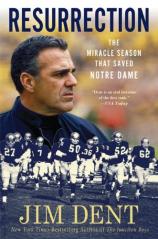Resurrection: The Miracle Season That Saved Notre Dame Football
Review
Resurrection: The Miracle Season That Saved Notre Dame Football
Send a volley cheer on high,
Shake down the thunder from the sky!
What though the odds be great or small,
Old Notre Dame will win over all,
While her loyal sons are marching
Onward to victory!
Love them or loathe them, the Fighting Irish of Notre Dame
represent the game and history of college football unlike any other
university. In the 1920s and ’30s, the Knute Rockne-coached
Irish were the dominant team on the nation’s sports pages.
The legendary Four Horsemen became household names, and Notre Dame
played to packed stadiums from Los Angeles to New York City. Ten
years after Rockne’s death, Frank Leahy took command of the
program, and the football juggernaut remained a national
powerhouse.
Success, however, can yield unintended consequences. Rockne and
Leahy became more powerful than Notre Dame itself. The school,
longing for recognition as an academic institution, was instead
viewed as a football factory. In the 1940s Notre Dame President
Father John Cavanaugh and athletic chairman Father Theodore
Hesburgh commenced a campaign to rein in the football program.
Scholarships were reduced, and in 1953, Leahy was relieved of his
head coaching duties for health reasons. The next decade would find
Notre Dame football on a downward spiral that brought the program
to the brink of collapse.
RESURRECTION chronicles the 1964 football season that returned
Notre Dame to national prominence. Author Jim Dent, whose college
football histories include THE JUNCTION BOYS and THE UNDEFEATED,
has written a compelling and fascinating history of coaches and
players who wanted nothing more than an opportunity to show the
football world that they could rise to the quality long expected of
a football powerhouse. The goal was accomplished, honestly and
within NCAA rules, through hard work, brilliant coaching and, as
might be expected, some pinches of good luck.
While the decision to de-emphasize football perhaps went too
far, Notre Dame’s football demise also came from a failure to
modernize the program. After Leahy’s departure, Terry
Brennan, Joe Kuharich and Hugh Devore led the team to successively
worse seasons. All had played and been connected with the glory
days of Notre Dame football, yet none had the coaching ability to
continue the winning Notre Dame tradition. But non-members of the
Fighting Irish family were not invited to join the University.
Notre Dame’s resurgence came about when the coaching mold
was smashed. A new coach, Ara Parseghian, was not a Notre Dame
graduate and was not even Catholic. He was an Armenian who had
built a successful program at Northwestern University. Indeed, his
Wildcat teams defeated Notre Dame four consecutive seasons. But
Parseghian was only available because Northwestern had not extended
his contract. Notre Dame did their homework and found in Parseghian
a young, hard-working, honest coach who followed NCAA rules and
would run an honest program. At Notre Dame, Parseghian found the
things he lacked at Northwestern: a national stage and a football
tradition.
Upon his arrival in South Bend, Pareseghian brought on a host of
talented players. In the 1950s and ’60s college recruiting
was far different than it is today. Notre Dame, the Catholic
College of America, always had great players who wanted to attend
the school simply because of its reputation and because they were
Catholic. The players were not the cause of Notre Dame’s
losing seasons. All those who turned the program around in 1964 had
been recruited by Devore and were on campus to greet their new
coach. While Devore brought great players to his program, he could
not coach his way out of a paper bag.
From spring until fall, Parseghian feverishly prepared his team
for the upcoming season. The first game was a resounding victory
over Wisconsin. In that contest the passing duo of quarterback John
Huarte and receiver Jack Snow emerged. Parseghian disdained a
smash-mouth running game and modernized Notre Dame’s offense
with a strategy of throwing the football downfield. Huarte would
win the Heisman Trophy in 1964, but could not even bring a letter
jacket to the award ceremony because in previous years at Notre
Dame he had mainly occupied a seat on the bench.
RESURRECTION is the story of how football games are won and
legends are born. The formula is still the same today as in 1964.
Innovative coaching and devoted players lead to victory. Almost
every starting player on the 1964 squad was overlooked by prior
coaching staffs or played a different position. Running backs
became defensive linemen for Parseghian. Players lost on the bench
became stars. No detail was overlooked, even uniforms were
redesigned to accentuate speed. The Notre Dame Cinderella season
ended in defeat in Los Angeles as USC rallied to defeat the Irish
and end their hopes of a national championship. It’s hard to
remember that, in 1964, the administration at Notre Dame would not
even send their squad to a bowl game. In future years, as college
football became a financial gold mine, that policy would change and
Parseghian would lead the Irish to bowl games and national
championships.
While recent years once again have not been kind to Notre Dame
football fortunes, reminiscences of the 1964 season remind fans
that the potential for a turnaround in football is only a few games
away. Jim Dent has written a wonderful book that reminds us all how
exciting college football was in the era before money, television
and the Bowl Championship Series tarnished the game. Football fans,
regardless of their feelings toward the Fighting Irish, will enjoy
this saga of a glorious era in college football.
Reviewed by Stuart Shiffman on January 23, 2011
Resurrection: The Miracle Season That Saved Notre Dame Football
- Publication Date: August 31, 2010
- Genres: Nonfiction, Sports
- Paperback: 336 pages
- Publisher: St. Martin's Griffin
- ISBN-10: 0312650175
- ISBN-13: 9780312650179





